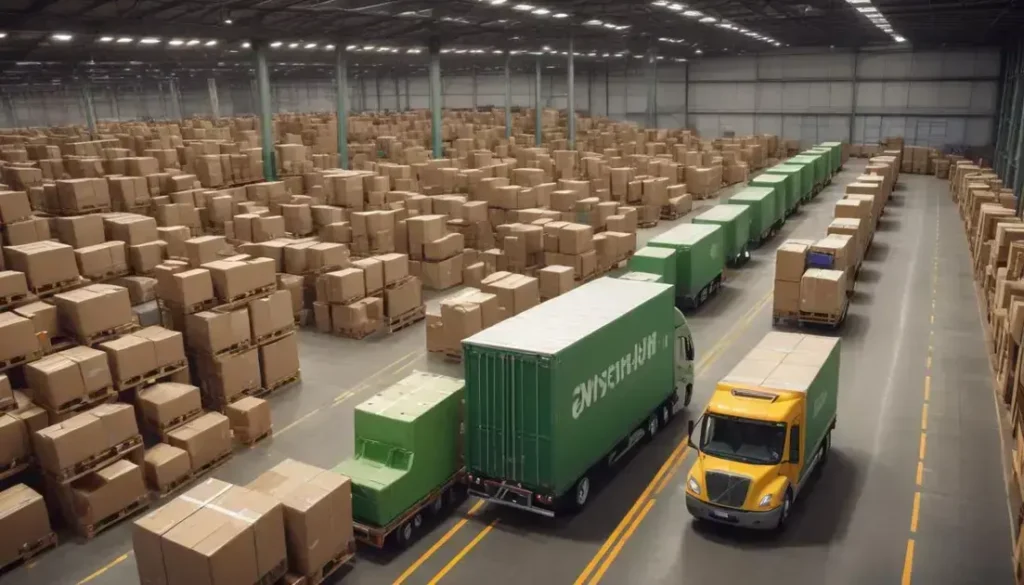Emissions regulations are legal standards aimed at reducing greenhouse gas emissions from vehicles, prompting the automotive industry to adopt sustainable practices, invest in electric vehicles, and innovate compliance strategies to meet government targets.
The rise of emissions regulations looms large over the automotive industry as companies like Stellantis face pressures to adapt quickly.
Overview of Stellantis and its brands
Stellantis, uma das maiores montadoras do mundo, emergiu da fusão entre a Fiat Chrysler Automobiles (FCA) e o Grupo PSA. Essa união resultou em uma vasta gama de marcas icônicas, incluindo Jeep, Peugeot, Fiat e Citroën. Com uma presença robusta em mercados globais, Stellantis se posiciona de forma estratégica para enfrentar os desafios da indústria automotiva moderna.
Portfólio Diversificado: O portfólio da Stellantis é notável pela diversidade. Cada marca mantém sua identidade única enquanto contribui para a inovação tecnológica e sustentabilidade. A empresa investe pesadamente em pesquisa e desenvolvimento, focando em veículos elétricos e híbridos, refletindo as crescentes demandas dos consumidores por opções mais ecológicas.
A Stellantis também encara desafios regulatórios significativos, especialmente em relação às emissões de CO2. As novas políticas de emissão na Europa e em outras regiões exigem que a empresa adapte sua linha de produtos rapidamente. Isso não apenas impacta sua distribuição global, mas também influencia suas decisões de fabricação e design de veículos, tornando-se crucial para o sucesso futuro da empresa.
Impact of EU emissions rules on car manufacturers
As the European Union (EU) tightens its emissions rules, car manufacturers face significant operational challenges. These regulations aim to reduce greenhouse gas emissions and promote sustainable practices across the automotive industry. For manufacturers, this means a shift towards electric vehicles (EVs) and hybrid models to meet stringent emission targets.
Implementation Costs: Adapting to these new rules involves substantial costs related to research, development, and infrastructure upgrades. Manufacturers must invest in innovative technologies while ensuring that existing models comply with the revised standards. Failure to adapt could lead to hefty fines and loss of market share.
Moreover, manufacturers that embrace these changes can gain a competitive advantage. There is a growing demand for low-emission vehicles, and those who lead in EV technology may capture a larger market audience. As EU policies evolve, manufacturers are also confronted with the challenge of aligning production processes and supply chains with sustainability goals.
The impact extends beyond compliance; it significantly influences consumer preferences and market trends. With increasing environmental awareness, consumers are leaning toward brands that demonstrate commitment to reducing their carbon footprint. Meeting EU emissions regulations is not just a regulatory necessity but also a pathway to reputational enhancement in a crowded marketplace.
Potential factory closures in Europe and the UK
The potential for factory closures in Europe and the UK is a pressing concern for the automotive industry. As manufacturers grapple with stringent emissions regulations, many are forced to reassess their operational strategies. This reevaluation often leads to tough decisions, including the possibility of closing production facilities.
Economic Implications: Factory closures can have severe economic repercussions. They not only affect the workforce but also ripple through local communities that depend on these plants for employment. Unemployment rates could rise sharply, leading to decreased consumer spending and local economic decline.
Furthermore, these closures may disrupt supply chains, creating challenges for companies relying on components produced in affected factories. Manufacturers could face delays, increased costs, and difficulties in meeting market demands, ultimately impacting their competitiveness.
Yet, there is a silver lining. Manufacturers are increasingly investing in modernising facilities to produce electric vehicles and meet sustainability targets. While some plants may close, others might be repurposed or upgraded, leading to new job opportunities in emerging sectors of the industry. The transition towards a greener economy presents both challenges and potential growth for the automotive manufacturing sector.
Stellantis’s response to tightening regulations
Stellantis’s response to tightening emissions regulations reflects its commitment to sustainability and innovation. The company has embarked on an ambitious strategy to transition towards electric vehicles (EVs) and hybrid models, aligning its product lines with new regulatory standards.
Investments in clean technology are central to Stellantis’s approach. The company has pledged billions towards developing electric and sustainable vehicles, aiming to release a wide range of models equipped with advanced EV technology. This not only helps meet regulatory requirements but also positions Stellantis as a leader in the transition to a greener automotive industry.
Furthermore, Stellantis is enhancing its manufacturing processes to reduce emissions across its production facilities. Implementing more efficient practices and renewable energy sources in factories is a key part of this plan. The goal is to achieve carbon neutrality by 2025, with a clear roadmap outlining milestones for each year.
As part of its strategy, Stellantis is also collaborating with governments and stakeholders to ensure its practices align with broader environmental goals. By taking proactive steps, the company demonstrates its responsiveness to regulatory changes while capitalising on the growing consumer demand for environmentally-friendly vehicles.
Electric vehicle market growth and sales targets
The growth of the electric vehicle (EV) market has been significant in recent years, driven by increasing consumer demand and supportive government policies. Automakers are rapidly adjusting their strategies to meet this shift towards sustainability, with ambitious sales targets set for the coming years.
Many key players in the automotive industry are pledging to transition their product lines heavily towards EVs, aiming for substantial increases in production. For instance, several manufacturers have stated intentions to sell only electric models by the early 2030s. This commitment is underpinned by the need to comply with stringent emissions regulations and to capture a growing segment of environmentally-conscious consumers.
Moreover, advancements in battery technology are also fueling this market expansion. As battery costs decrease and range improves, consumers are becoming more willing to switch from traditional internal combustion engine vehicles to EVs. This trend is reflected in sales figures, with many markets reporting record EV sales in the past year.
Notably, the rise of EVs is not just limited to passenger cars; the commercial vehicle segment is also seeing increased investment. Companies are exploring electric solutions for fleets, contributing to a broader shift across various transport sectors. Overall, the future of mobility is increasingly electric, with innovative technologies driving this transformation.
Current Stellantis factory operations
The current operations at Stellantis factories are a reflection of the company’s commitment to innovation and efficiency. As one of the largest automotive manufacturers in the world, Stellantis operates a network of facilities that produce a diverse range of vehicles, from traditional combustion engines to cutting-edge electric models.
These factories are at the forefront of implementing advanced manufacturing techniques. Using Industry 4.0 technologies such as automation and IoT (Internet of Things), Stellantis aims to enhance production efficiency and reduce waste. This transition not only helps in meeting growing market demands but also aligns with sustainability goals.
Stellantis’s facilities are strategically located to optimise supply chains and reduce logistics costs. By utilising a mix of local resources and global partnerships, the company ensures a steady flow of components required for assembly. In addition, the factories are increasingly focusing on adapting to environmental regulations, with initiatives aimed at minimising emissions and energy consumption.
Furthermore, the company is investing in workforce training to ensure that employees are equipped with the skills needed to operate new technologies. This focus on talent development is crucial for maintaining competitiveness in the evolving automotive landscape, allowing Stellantis to navigate the challenges posed by shifting consumer preferences and regulatory pressures.
The role of the UK’s net-zero policies
The UK’s net-zero policies play a crucial role in shaping the future of the automotive industry, particularly for manufacturers like Stellantis. These policies aim to reduce greenhouse gas emissions to net-zero by 2050, encouraging companies to adopt more sustainable practices. Automakers are responding by investing heavily in electric vehicle (EV) technology and alternative fuel solutions.
Compliance with Regulations: To remain competitive, manufacturers must comply with these stringent regulations. This involves a shift in production processes and vehicle design, ensuring that new models meet emissions targets. The UK government has also introduced incentives for consumers to switch to EVs, making them more financially attractive.
Furthermore, the transition towards a net-zero economy includes promoting public transport and enhancing charging infrastructure. This creates a supportive ecosystem for EV adoption, which is essential for reducing the overall carbon footprint of transportation.
In addition to environmental benefits, these policies stimulate economic growth by opening up new market opportunities and creating jobs in green technologies. The demand for skilled workers in EV manufacturing, battery technology, and renewable energy solutions is expected to rise significantly. Overall, the UK’s net-zero policies are not just about compliance; they are a catalyst for innovation and transformation within the automotive sector.
Job risks associated with factory closures
Factory closures present significant job risks for employees within the automotive industry. As manufacturers like Stellantis navigate tightening regulations and market shifts towards electric vehicles, the downsizing of operations can lead to widespread job losses. Many workers, particularly those in manufacturing roles, face uncertainty about their future employment.
Economic Impact: The immediate effect of factory closures extends beyond individual workers. Entire communities can suffer economically, especially in regions heavily reliant on manufacturing jobs. This can result in decreased local spending, increased unemployment rates, and a ripple effect on related businesses and services.
Moreover, the transition to electric and hybrid vehicle production requires a different skill set. Many employees may not possess the necessary training to adapt to new technologies and processes. Consequently, retraining and upskilling initiatives are crucial for those displaced by factory closures, allowing them to transition into different roles within the evolving automotive landscape.
Companies investing in these workers’ futures can enhance their reputations while supporting local economies. Initiatives that focus on reskilling programs and job placement services can help ease the transition for affected workers. As the industry shifts, addressing the human cost of these closures remains a priority for manufacturers aiming for sustainable growth.
Insights from industry leaders
Insights from industry leaders provide valuable perspectives on the evolving automotive landscape, particularly concerning the transition to electric vehicles (EVs) and sustainability efforts. Leading executives often emphasise the need for innovation and adaptability in response to changing consumer demands and regulatory pressures. These leaders frequently highlight the importance of investing in research and development. Companies that prioritise R&D are more likely to stay ahead of the curve by developing advanced technologies that enhance vehicle performance, efficiency, and safety. As the market shifts toward environmentally-friendly solutions, innovation becomes crucial for maintaining a competitive edge. Collaboration is another key theme in industry discussions. Leaders consistently advocate for partnerships across the supply chain, including alliances with tech firms, researchers, and government bodies. Such collaborations can accelerate the development of EV infrastructure, like charging networks, and optimize the sourcing of sustainable materials. Finally, industry leaders stress the significance of employee engagement and training in adapting to new technologies. By fostering a culture of continuous learning, companies can equip their workforce with the necessary skills to thrive in a rapidly changing environment. The insights provided by these leaders shape the trajectory of the automotive sector, offering guidance on navigating the complexities of modern manufacturing and environmental responsibility.
Government responses to emissions challenges
Government responses to emissions challenges are pivotal in shaping the future of the automotive industry. As the pressure mounts to address climate change, administrations worldwide are implementing stringent emissions regulations to encourage manufacturers to adopt sustainable practices. These regulatory frameworks often include ambitious targets to reduce greenhouse gas emissions significantly.
One common approach involves offering incentives for consumers to switch to electric vehicles (EVs). Subsidies, tax breaks, and grants aim to make EVs more affordable, driving demand and incentivising manufacturers to increase production. Governments are also investing in expanding charging infrastructure, essential for supporting the widespread adoption of electric vehicles.
In addition to financial incentives, regulatory measures such as cap-and-trade systems and emissions trading schemes are gaining traction. These initiatives compel companies to measure and reduce their emissions, promoting a shift towards cleaner technologies. Failure to comply can result in significant financial penalties, further motivating manufacturers to innovate.
Collaboration between governments and industry stakeholders is also crucial. Frequent consultations help ensure that regulations are realistic and achievable while pushing manufacturers towards greener goals. By fostering an environment conducive to innovation and collaboration, governments can effectively tackle emissions challenges and steer the automotive industry towards a sustainable future.
Investment implications for Australian businesses
The investment implications for Australian businesses in the wake of global shifts towards sustainability and clean energy are profound. As regulations tighten and consumer preferences evolve, companies must reassess their investment strategies to align with emissions reduction goals and the transition to electric vehicles (EVs).
Investors are increasingly interested in supporting businesses that demonstrate a commitment to sustainability. Companies that fail to adapt may face higher capital costs and reduced access to funding. In contrast, those that embrace green technologies can attract significant investment opportunities, enabling them to finance the development of innovative products and services.
Furthermore, the rise of environmental, social, and governance (ESG) criteria in investment decisions highlights the importance of sustainable practices. Australian businesses must focus on integrating ESG principles into their operations to maintain competitiveness and attract responsible investors. This shift not only enhances the company’s reputation but can also lead to financial benefits through operational efficiencies and lower energy costs.
Government incentives aimed at promoting sustainability also play a key role in guiding investments. Grants and subsidies for green technology can reduce initial costs, making it easier for companies to invest in sustainable solutions. Overall, adapting to these changes is essential for Australian businesses looking to thrive in a rapidly evolving market that prioritises environmental responsibility.
Future outlook on emissions regulations and compliance strategies
The future outlook on emissions regulations signifies a trend towards stricter compliance measures for automotive manufacturers. As environmental concerns mount, governments worldwide are expected to implement more rigorous standards aimed at achieving sustainability targets. This shift will compel businesses to continually adapt their practices in alignment with evolving regulations.
Manufacturers must anticipate these changes by embracing compliance strategies that focus on innovation and efficiency. This includes investing in cleaner technologies, enhancing production processes, and incorporating renewable energy sources into manufacturing. A proactive stance not only ensures adherence to regulations but also positions companies as leaders in sustainability.
Moreover, the integration of digital tools for monitoring emissions will become increasingly relevant. Advanced data analytics allow for real-time tracking and reporting, facilitating more effective compliance management. Companies leveraging these technologies can respond quickly to regulatory changes and minimise compliance risks.
Additionally, collaborations with industry stakeholders, such as government entities and environmental organisations, will be crucial. Engaging in dialogue to shape future regulations can lead to a more favourable operating environment. Overall, the future of emissions regulations will present both challenges and opportunities, and companies that strategically adapt will thrive in this rapidly changing landscape.
In Summary: The Future of the Automotive Industry
The automotive industry is facing exciting yet challenging times as it adapts to new emissions regulations and shifts towards sustainable practices.
As companies invest in electric vehicles and clean technologies, they not only comply with regulations but also meet the changing preferences of consumers. Industry leaders are prioritising innovation, collaboration, and employee training to navigate this transformation successfully.
Understanding government policies and market trends will be essential for businesses to thrive. By embracing these changes, Australian companies can set a benchmark for environmental responsibility and achieve long-term growth.
Thus, the journey toward sustainability and compliance presents great opportunities that can transform the automotive sector.
Frequently Asked Questions
What are emissions regulations, and why are they important?
Emissions regulations are laws set by governments to limit the amount of greenhouse gases that vehicles can emit. They are important because they help reduce air pollution and combat climate change.
How is the automotive industry adapting to sustainability?
The automotive industry is adapting by investing in electric vehicles, implementing clean technologies, and focusing on sustainable manufacturing practices to meet environmental standards.
What role do government incentives play in promoting electric vehicles?
Government incentives, such as tax breaks and subsidies, make electric vehicles more affordable for consumers, encouraging more people to make the switch from traditional cars.
Why is collaboration important in the automotive sector?
Collaboration among industry stakeholders, including manufacturers, governments, and environmental organisations, is crucial for developing effective policies and technologies that support sustainability.
What can businesses do to prepare for future emissions regulations?
Businesses should invest in cleaner technologies, enhance their production processes, and stay informed about regulatory changes to ensure compliance and competitiveness.
How does the transition to electric vehicles affect jobs in the automotive industry?
While the transition to electric vehicles may lead to job losses in traditional manufacturing roles, it also creates new opportunities in areas like EV production, battery technology, and sustainable practices.


